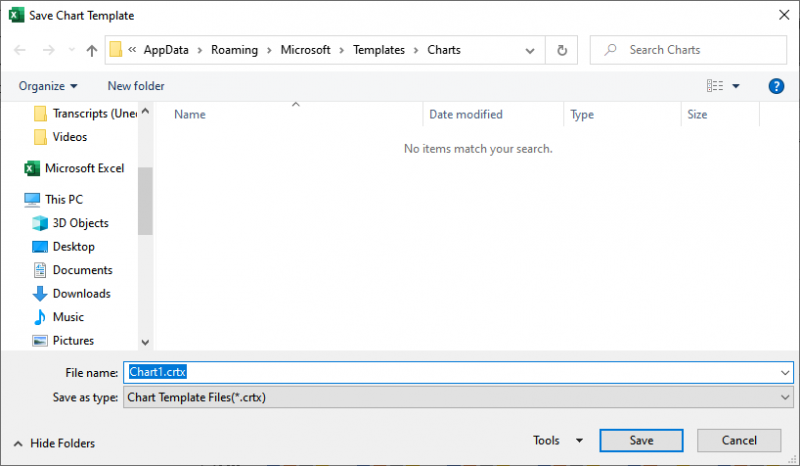Written by Allen Wyatt (last updated August 20, 2022)
This tip applies to Excel 2007, 2010, 2013, 2016, 2019, 2021, and Excel in Microsoft 365
Peter is getting older (aren't we all?) and his vision is getting older along with him. When he creates a chart, Excel uses a light gray tone for axis and grid lines. Peter finds these hard to see with his old eyes, so he wonders if there is a way to change the default for axis and grid lines to black.
The easiest way to handle this is to create your own chart template. Here's the general steps for accomplishing the task:

Figure 1. Saving a chart template.
Excel saves the chart type with the template, so if you use different types of charts in your work, you'll want to create a template for each type.
In order to later use the template, all you need to do is to right-click on any chart and, from the resulting Context menu, choose Change Chart Type. Excel then displays the Change Chart Type dialog box. Click Templates at the left side of the dialog box and you can see the template you previously saved, along with any other templates you defined. (See Figure 2.)

Figure 2. Using a chart template.
When you click on one of the templates and click OK, Excel formats the chart to match the settings in the template.
Interestingly enough, if you use one of your templates disproportionately more often than others, you can set the template as the default chart type. All you need to do, when the Change Chart Type dialog box is displayed, is to right-click on the template you want used as the default and, from the Context menu, choose Set As Default Chart. Now whenever you create a new chart, Excel should rely on the template as the starting point for your chart.
ExcelTips is your source for cost-effective Microsoft Excel training. This tip (10047) applies to Microsoft Excel 2007, 2010, 2013, 2016, 2019, 2021, and Excel in Microsoft 365.

Dive Deep into Macros! Make Excel do things you thought were impossible, discover techniques you won't find anywhere else, and create powerful automated reports. Bill Jelen and Tracy Syrstad help you instantly visualize information to make it actionable. You’ll find step-by-step instructions, real-world case studies, and 50 workbooks packed with examples and solutions. Check out Microsoft Excel 2019 VBA and Macros today!
Most charts you create in Excel are based on information stored in a worksheet. You can also create charts based on ...
Discover MoreWhen formatting a chart, you might want to change the characteristics of the font used in various chart elements. This ...
Discover MoreWhen you are working with embedded charts in a workbook, you may want to resize them to a specific size. This tip looks ...
Discover MoreFREE SERVICE: Get tips like this every week in ExcelTips, a free productivity newsletter. Enter your address and click "Subscribe."
There are currently no comments for this tip. (Be the first to leave your comment—just use the simple form above!)
Got a version of Excel that uses the ribbon interface (Excel 2007 or later)? This site is for you! If you use an earlier version of Excel, visit our ExcelTips site focusing on the menu interface.
FREE SERVICE: Get tips like this every week in ExcelTips, a free productivity newsletter. Enter your address and click "Subscribe."
Copyright © 2025 Sharon Parq Associates, Inc.
Comments